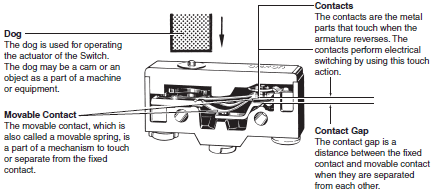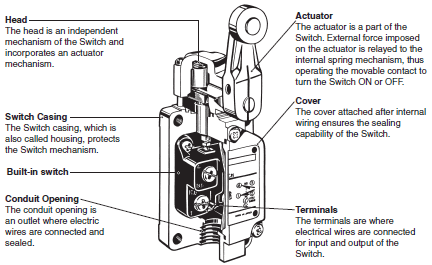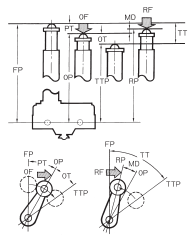Limit Switches
|
|
Features |
| Principles | Classifications |
| Engineering Data |
|
| Explanation of Terms |
|
General Terms
Limit Switch
A Built-in switch enclosed in a metal or resin case to protect it from external forces, water, oil, dust, dirt, etc. Also abbreviated to merely “Switch”.
Ratings
Generally, the ratings of the Switch refer to values that ensures the characteristics and performance of the Switch, such as rated current and rated voltage under specific conditions.
Contacts
Contacts are mechanically opened and closed for current switching.
Contact Configuration
The electrical input/output circuit configuration of contacts which depends on the application.
Resin Molding (Molded Terminals)
Terminals that are hardened by applying resin after lead wires have been connected in order to eliminate any exposed current-carrying parts and to improve sealing performance.

Terms Related to Configuration and Structure

Terms Related to Switch Durability
Mechanical Durability
The mechanical durability refers to the number of available switching operations on condition that the Switch is actuated to the OT position per operation.
Electrical Durability
The electrical durability is the switching durability at the rated load (i.e., a resistive load) with overtravel set as the reference value.
Terms Related to Characteristics
FP (Free Position)
The initial position of the actuator when no external force is applied.
OP (Operating Position)
The position where the movable contact reverses from the free position when an external force is applied to the actuator.
TTP (Total Travel Position)
The position of the actuator when it reaches the stopper.
RP (Releasing Position)
The actuator position where the movable contacts reverse from the operating position to the free position when the external force on the actuator is reduced.
OF (Operating Force)
The force applied to the actuator required to operate the switch contacts.
RF (Releasing Force)
The value to which the force on the actuator must be reduced to allow the contacts to return to the normal position.
PT (Pretravel)
The distance or angle through which the actuator moves from the free position to the operating position.
OT (Overtravel)
The distance or angle through which the actuator moves from the operating position to the total travel position.
MD (Movement Differential)
The distance or angle from the operating position to the releasing position.
TT (Total Travel)
The distance or angle through which the actuator moves from the free position to the total travel position.

Terms Used in EN 60947-5-1 Standards
The following provides information on the following terms used in this catalog.
EN 60947-5-1
EN standards applicable to electronic machine control circuitry, the contents of which are the same as those of IEC 60947-5-1.
Application Category
Switch application categories. Refer to the following examples.
| Type of current | Category | Typical application |
| AC | AC-15 | Control of electromagnetic loads exceeding 72 VA |
| AC-14 | Control of electromagnetic loads not exceeding 72 VA | |
| DC | DC-12 | Control of resistive loads and semiconductor loads |
Rated Operating Current (Ie)
Rated current for the Switch to operate.
Rated Operating Voltage (Ue)
The rated switch operating voltage, which must not exceed the rated insulation voltage (Ui).
Rated Insulation Voltage (Ui)
The maximum rated voltage at which the insulation voltage of the Switch is maintained. This value is used as the parameter of the dielectric strength and creepage distance of the Switch.
Conventional Enclosed Thermal Current (I the)
The normal carry current that does not increase the permissible upper-limit temperature of the Switch if it is a model with its charged part sealed. The rated permissible upper-limit temperature is 65°C if the terminals are made of brass.
Rated Impulse Dielectric Strength (Uimp)
The peak impulse voltage that the Switch can withstand with no insulation breakage.
Conditional Short-circuit Current
The current that the Switch can withstand until the circuit breaker operates.
Short-circuit Protective Device (SCPD)
The device, such as a breaker or fuse, which breaks the current to protect the Switch from short-circuiting.
Pollution Degree
The environment in which the Switch is used.
The pollution degree is divided into four levels as shown below. The Switch falls under pollution degree 3.
| Level | Description |
| Pollution degree 1 | No pollution or only dry, non-conductive pollutants exist. |
| Pollution degree 2 | Normally only non-conductive pollutants exist, which are expected to be temporarily conductive due to condensation. |
| Pollution degree 3 | Conductive pollutants exist or existing nonconductive pollutants will be temporarily conductive due to expected condensation. |
| Pollution degree 4 | There are pollutants that are continuously conductive due to rain, snow, or conductive dust. |
Protection Against Electric Shock
This is the electric shock prevention level. There are the following four levels.
| Level | Description |
| Class 0 | Electric shocks are prevented by basic insulation only. |
| Class I | Electric shocks are prevented by basic insulation and grounding. |
| Class II | Electric shocks are prevented by double insulation or reinforced insulation with no grounding required. |
| Class III | No countermeasures against electric shocks are required because the electric circuits in use operate in a low-enough voltage range. |
Closed-circuit Counter Electromotive Voltage
Instantaneous overvoltage generated from the closed circuit, which must not exceed the Uimp value.
Space Distance
The minimum space distance between two charged parts.
Creepage Distance
The minimum distance on the surface of the insulator between two charged parts.
Distance through Insulation
The minimum direct distance between the charged part and the nonmetal switch housing through air or any other insulator.